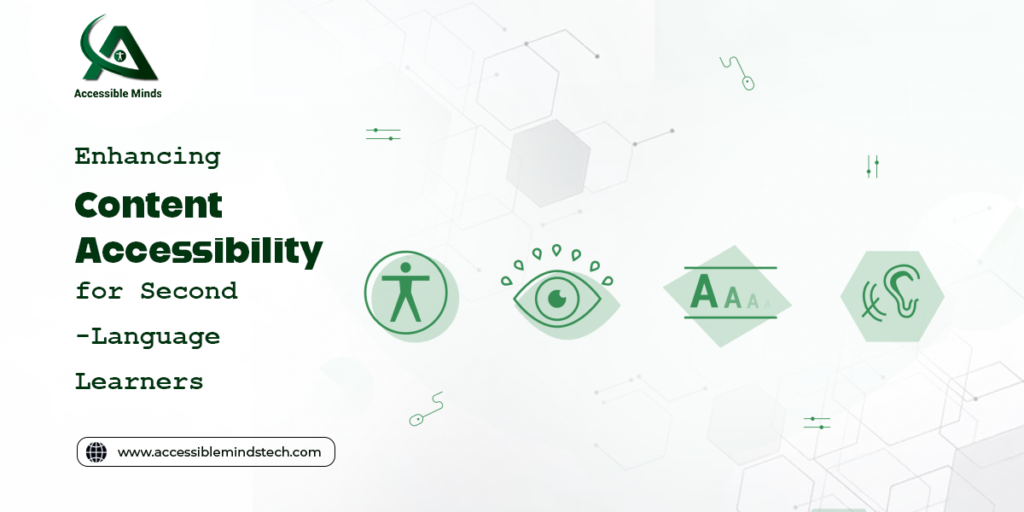In today’s interconnected world, digital content must cater to diverse audiences, including second-language learners. These individuals often face unique challenges, such as language barriers, unfamiliar cultural contexts, and difficulty navigating complex digital platforms. Enhancing content accessibility for second-language learners is not just about inclusivity—it’s about ensuring equitable access to information and services. This is where Digital Accessibility Testing Services play a crucial role in creating a user-friendly experience.
This blog explores the key challenges faced by second-language learners, actionable strategies to enhance accessibility, and the vital role of digital accessibility testing in making content universally accessible.
Challenges Faced by Second-Language Learners
- Language Proficiency Barriers
Second-language learners may struggle with complex vocabulary, technical jargon, or idiomatic expressions, making it difficult to comprehend content. - Navigation Difficulties
Unfamiliarity with interface designs or language-specific labels can make navigation cumbersome, especially on platforms with non-intuitive layouts. - Cultural Differences
Content designed with culturally specific references or metaphors may alienate users from different backgrounds. - Visual and Auditory Overload
Excessive use of visuals, animations, or audio without proper captions or explanations can confuse users who rely on text-based learning.
Strategies to Enhance Content Accessibility
1. Simplify Language
- Use plain language and avoid jargon or slang.
- Provide glossaries for technical terms.
- Break content into smaller, digestible sections to aid comprehension.
2. Offer Multilingual Support
- Translate content into multiple languages relevant to your audience.
- Use professional translators to ensure cultural nuances are accurately conveyed.
3. Provide Audio and Visual Alternatives
- Include subtitles for videos and transcripts for audio content.
- Use visual aids like diagrams or images with descriptive text to support textual explanations.
4. Ensure Intuitive Navigation
- Design clear, simple navigation menus.
- Use recognizable icons and consistent labeling across pages.
- Offer a search function with multilingual capabilities.
5. Leverage Assistive Technology
- Integrate tools like text-to-speech converters and screen readers.
- Test the compatibility of these tools with your digital platform.
6. Incorporate Interactive Features
- Use quizzes or interactive elements to reinforce understanding.
- Allow users to customize their experience, such as adjusting font size or switching to a preferred language.
7. Focus on Culturally Inclusive Design
- Avoid region-specific metaphors or idioms that might not resonate with global audiences.
- Use neutral imagery and examples relatable to a diverse demographic.
Role of Digital Accessibility Testing Services
What Are Digital Accessibility Testing Services?
These services specialize in assessing digital platforms for compliance with accessibility standards such as WCAG (Web Content Accessibility Guidelines). By identifying barriers, these services help ensure that content is accessible to all users, including second-language learners.
How Do They Help Second-Language Learners?
- Evaluating Language Simplicity
Accessibility testing services assess whether the language used in your content is easy to understand for non-native speakers. They identify areas where complex terms or unclear instructions might hinder comprehension. - Testing Multilingual Interfaces
These services ensure that multilingual interfaces function seamlessly, from accurate translations to smooth navigation. - Assessing Compatibility with Assistive Technologies
Accessibility testing verifies that your platform works effectively with tools like screen readers and language translation software, critical for second-language learners. - Auditing Visual and Audio Accessibility
Testing services examine whether videos have accurate subtitles, images have descriptive alt text, and audio content includes comprehensive transcripts. - Ensuring Compliance with Accessibility Standards
Digital Accessibility Testing Services help businesses meet global standards like WCAG, ensuring content is accessible to diverse user groups.
Tools and Technologies to Enhance Accessibility
- Screen Readers: Tools like JAWS or NVDA convert on-screen text into speech, aiding those with limited language proficiency.
- Text-to-Speech Software: Converts written text into spoken words, assisting users who learn better through auditory input.
- Translation Tools: Platforms like Google Translate or AI-driven services provide on-demand language support.
- Interactive Tutorials: Tools like WalkMe guide users step-by-step through complex processes.
Benefits of Enhancing Accessibility for Second-Language Learners
- Broader Audience Reach
By catering to second-language learners, you expand your potential audience, increasing engagement and brand loyalty. - Improved User Experience
Accessible content creates a seamless experience, reducing frustration and encouraging repeated visits. - Compliance and Legal Security
Adhering to accessibility standards helps avoid legal complications and demonstrates corporate social responsibility. - Enhanced Reputation
Businesses that prioritize accessibility are seen as inclusive and forward-thinking, which strengthens their market position. - Higher Conversion Rates
When users can easily understand and interact with your content, they are more likely to take desired actions, such as making purchases or signing up for services.
Case Study: Improving Accessibility with Digital Accessibility Testing Services
Challenge: A global e-learning platform noticed low engagement from non-native English speakers.
Solution: They partnered with Accessible Minds to audit their platform. The audit identified several barriers, including complex language, untranslated sections, and poor screen reader compatibility.
Actions Taken:
- Simplified course content and added glossaries.
- Implemented multilingual support for their platform.
- Ensured all videos included captions and transcripts.
- Optimized the site for assistive technologies like screen readers.
Outcome: The platform saw a 40% increase in engagement from second-language learners and a 25% rise in overall course completion rates.
Conclusion
Enhancing content accessibility for second-language learners is a vital step toward inclusivity and user satisfaction. By addressing language barriers, simplifying navigation, and leveraging tools like Digital Accessibility Testing Services, businesses can create a more welcoming and effective digital experience.
Investing in accessibility is not just about meeting standards—it’s about empowering every user to engage with your content confidently. Start prioritizing accessibility today and unlock the potential of a truly global audience.

